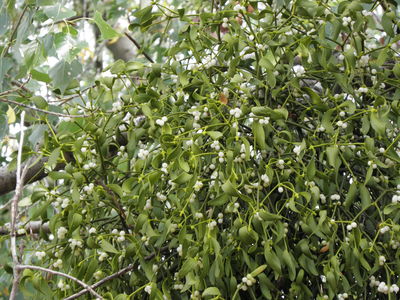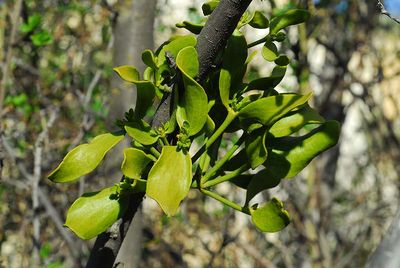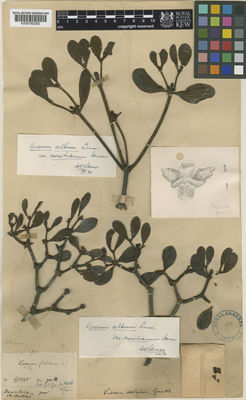Geography and distribution
Mistletoe ranges from North Africa to southern England and southern Scandinavia, across Central Europe to southwest and east Asia to Japan. In Europe three subspecies (ssps.), which grow on different species of host trees, have been recognised. Viscum album ssp. album grows on hardwoods, V. album ssp. abietis on fir trees ( Abies ) and V. album ssp. laxum grows on pines and spruce. Further east there are well-known forms of V.album which have coloured fruits.
In the UK V. album occurs from east Devon to Yorkshire, and is particularly common in central and southern England and around London.
Mistletoe is partially parasitic, growing on several woody hosts (trees and shrubs) in a variety of wooded habitats, extending from the tropics (typical V. album is recorded from the Chin Hills in Burma) into temperate regions. Across its geographical range, it can be found growing on gymnosperms as well as broadleaved trees. In the UK, poplar, lime, apple and hawthorn are common hosts. Mistletoes on native European oaks are rare.
Description
Viscum album is a small woody shrub, frequently globular in shape and can reach over 1 m in diameter. It grows on the branches of other trees, to which it is attached by a swelling called a haustorium. In common with all mistletoes, it is hemiparasitic which means that although it depends on its host for water and mineral nutrients, it is able to photosynthesise (create its own carbohydrates using sunlight) because it has green leaves and stems.
The stems of the mistletoe appear characteristically forked, (pseudo-dichotomously branched) and it is possible to estimate the age of a mistletoe bush simply by counting the number of times that the branches fork and adding two years (since often one fork is produced in each year from the third year after germination). V. album is dioecious, which means that male and female flowers are produced on separate plants. The small, easily overlooked flowers are produced in a short inflorescence of three to five flowers in the forks of the branches. Although small, the flowers are reported to be insect-pollinated and they are said to be sweetly scented and to produce nectar. The white berries appear from about October until May. Inside they contain a single green seed which lacks a seed coat but is surrounded by a sticky pulp.
Other common names
German: Mistel, Vogelmistel, Leimmistel, Affolter, Bocksfutter, Drudenfua, Elfklatte, Geiakrut, Guomol, Hexenbesen, Immergrune, Kluster, Marenklatte, Marentaken, Mischgle, Mischgelt, Misple, Nistle, Uomol, Vogelchrut, VogelKlab, Vogellim, Wespe, Wintergrun, Wispen, Wasp.
French: gui, gui commun, gui de druides
Italian: vischio, visco, vescovaggine, guatrice, pania, scoaggine
Spanish: muerdago
Threats and conservation
Viscum album is locally common in the UK. The most recent survey (1993-6) showed that, in its stronghold in the former apple orchard areas of the Welsh borders, the populations had fallen in numbers as a direct consequence of the decline of the orchards. In spite of this, the plant was still much more common in the counties of Gloucestershire, Herefordshire and Worcestershire, when compared with what are probably more natural frequencies found elsewhere.
Infestations of mistletoe are detrimental to the host tree, and large infestations can eventually lead to the host's death, particularly during prolonged periods of dry weather. As mistletoe reduces the productivity of commercial fruit trees it is often pruned out to try and stop its spread.
Uses
Mistletoe has had a long history of use in folk medicine. Druids (members of a priestly class active in Gaul during pre-Christian times) regarded mistletoe growing on oak as superior. Some of the constituent compounds of mistletoe affect the immune, circulatory and cardiac systems. Mistletoe has been used as an antiseptic, antispasmodic, astringent, digestive and diuretic, and, among the many ailments it has been used to treat, are epilepsy, ulcers, high blood pressure, rheumatism and certain types of cancer. Despite experimental anti-tumour effects, research is still underway to determine its clinical role, although the commercially available mistletoe extracts such as Iscador and Helixor are widely used as oncological drugs, particularly in Germany.
Druids used the plant as an aphrodisiac, and in Scandinavian tales it symbolises peace and love. Until the arrival of Christmas trees in the nineteenth century, the kissing bough held centre stage at Christmas, when a berry was plucked with each kiss until none was left. Today, mistletoe is still a favourite Christmas decoration.
Cultivation
Viscum album has been introduced to host trees in Kew Gardens many times, but has been difficult to establish. In 1996 seeds were placed on 14 different Malus species. None of these became a host but a nearby Crataegus monogyna now exhibits a good clump, which appears to be about eight to nine years old.
In 2004 a Kew Diploma student introduced locally-collected seed. He rubbed 20 seeds into the bark of each of nine suitable host trees. Mostly the sides or undersides of branches were used, with the pulp surrounding the seeds used as glue. The bark was not cut into at all. This process mimics seed dispersal by birds.
On one of the Malus trees in the trial, six seeds germinated, and by 2009 four of the plants were doing well. Three seeds germinated on a lime tree but the plants then disappeared. However, in autumn 2009, a new seedling appeared on the same lime tree. It is hoped that some of the trees on which seeds germinated but then disappeared may similarly produce more plants in the future.
Some authors suggest that the best method is to build up a store of good viable seed, which can be sown after winter, when the chance of predation by small birds such as tits is at its lowest. Seeds from robust, healthy bushes, collected from January onwards can be stored once the fruit skins have been removed and the seeds air-dried. Critically, the seeds must be stored in the light, as it seems that the green embryo needs to photosynthesise. The rehydrated seeds can then be sown from March onwards.
The Arboretum team at Kew collected more seeds during the winter of 2009 in order to continue research on the cultivation of mistletoe.
Kew and the mistletoe trade
Scientists in Kew's Sustainable Uses of Plants Group were commissioned by the Countryside Agency, English Nature and Scottish Natural Heritage to undertake research on the commercial uses of wild and traditionally managed plants in England and Scotland. Border towns between England and Wales, in Herefordshire, Gloucestershire, Shropshire and Worcestershire, are the traditional centres for mistletoe trade. Tenbury Wells (in Herefordshire) has the last remaining specialist mistletoe auctions based on material gathered by local orchard owners and their casual workers. Despite the English harvest, imports - mostly from France - seem to be the source of most seasonal mistletoe in the London markets. In recent years, small amounts of imported French mistletoe have even reached the market at Tenbury Wells, but 99% of mistletoe traded there is still collected in local counties.
Kiss of death?
Mistletoe contains a mixture of toxic proteins, viscotoxins and mistletoe lectins. The leaves and stems are reported to be more poisonous than the fruits, and there is some evidence that the toxicity depends on the species of tree on which mistletoe is growing. Most problems are likely to arise when mistletoe is cut and brought indoors (for example at Christmas-time), and usually involve children who have eaten the fruits. Reactions vary and depend on the age of the child and the number of fruits eaten. As few as three or four berries may produce mild stomach ache; if large numbers are eaten gastroenteritis and diarrhoea may result. Poisoning is rarely serious, but it is best to seek medical advice. Pets can be at risk; some cases of dog poisoning have been fatal.























